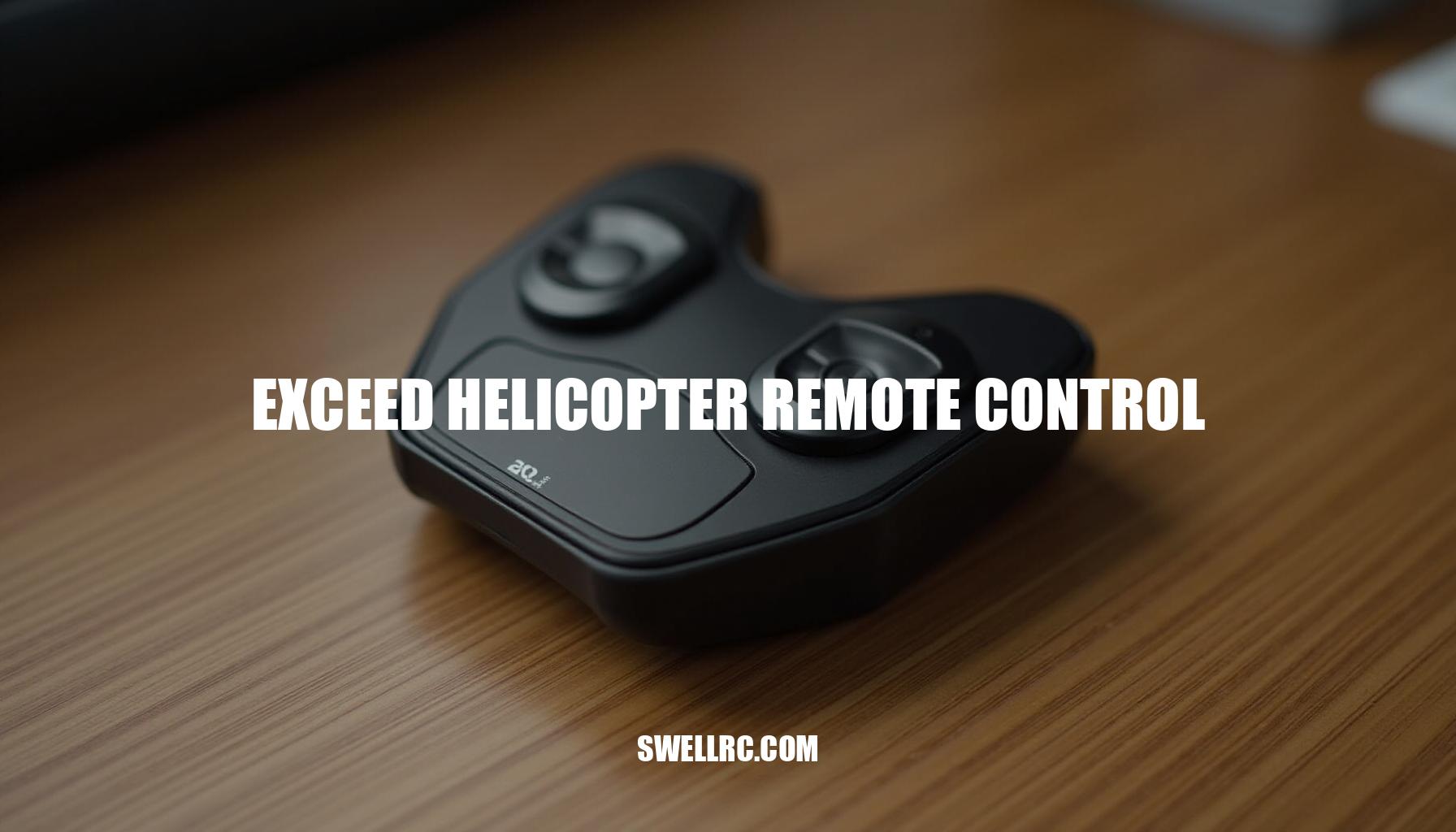Exceed Helicopter Remote Control Review: A Beginner-Friendly yet Durable Option
My first serious session with an Exceed heli started on a calm evening in the park—fresh battery, leveled pad, and that unmistakable whir climbing into a steady hover. The moment I eased in cyclic, the response felt clean and predictable, exactly what you want when you’re learning a new machine’s personality. That’s where Exceed tends to shine for me: approachable tuning out of the box and a build philosophy that balances fun, reliability, and upgrade potential.
RC helicopters have evolved impressively, with advances like lighter airframes, better gyros, and smarter transmitters enhancing helicopter flight stability for both indoor and outdoor RC flying. Exceed’s remote control aircraft models sit neatly in the sweet spot between entry-friendly handling and hobby-grade RC models’ tweakability. If you’re just getting your bearings in the world of remote control aircraft, this quick brand primer helps frame the lineup: Exceed remote control helicopter overview (https://www.swellrc.com/exceed-remote-control-helicopter/).
In the sections ahead, I’ll break down the tech, the feel in real flights, how Exceed stacks up to rivals, and the upgrades that made the biggest difference for me.
Understanding the core of Exceed RC helicopters
Under the canopy of the Exceed RC brand, the Exceed G2 helicopter showcases a straightforward recipe: keep weight sensible, pair it with a reliable power system, and let the gyro stabilization technology do the heavy lifting for stability. Typically, transmitter binding in bind-and-fly setups is painless—power on the model on a flat surface, bind the transmitter, let the gyro initialize, and you’re airborne. The power-to-weight ratio dictates punch and recovery out of turns; stabilization tempers twitchiness so beginners enjoy a forgiving hover while intermediates still have room to push.
Comparing the popular models—the Exceed G2 helicopter, Double Horse 9101, and Hero RC H911—you’ll feel three distinct design philosophies:
| Model | Flight Time | Rotor Type | Control Range | Stabilization & Handling |
|---|---|---|---|---|
| Exceed G2 | ~6–8 min on 1S packs | Mid-size single main rotor | Field-park friendly | Gyro stabilization tuned for smooth learning; balanced and stable |
| Double Horse 9101 | ~6–8 min | Large coaxial rotors | Shorter effective range vs. hobby-grade 2.4 GHz sets | Very docile response; floaty coaxial calm |
| Hero RC H911 | ~5–7 min (micro class) | Small rotor | Indoor capable | Nimble micro agility; quick cyclic with authority for light outdoor use |
After a few test flights back-to-back, the Exceed G2 helicopter gave me the clearest “I’ve got this” feeling—less pendulum than a coax, but not as twitchy as a tiny micro when wind picks up. For beginners, that middle ground matters; for experienced pilots, it’s a friendly canvas for tuning, thanks largely to its optimized gyro stabilization technology and balanced power-to-weight ratio. This thoughtful design, along with straightforward transmitter binding, makes the Exceed RC brand a reliable choice for pilots at every level.
Flight performance, control precision, and upgrade paths
When it comes to evaluating a helicopter’s performance out on the field, I focus on three critical aspects: how cleanly it holds a hover, how confidently it tracks during forward flight, and how predictably it responds when I ask for more. Exceed’s stock tuning typically delivers reliable control precision with a solid hover and smooth transitions into circuits. Adding a modest tail gain bump and some expo on the cyclic offers crisp inputs without causing overcorrection, enhancing transmitter tuning effectiveness.
Where to fly:
- Indoors: Micro Exceed variants and similar models excel in indoor environments, offering stable hover practice, nose-in training, and orientation drills that benefit from the controlled indoor RC flying conditions.
- Calm outdoor mornings: These are ideal for progressing into faster circuits, figure-eights, and stall turns, allowing pilots to experience the upgrade potential of their setups in more dynamic scenarios.
- Breezy afternoons: When conditions get windier, choosing a slightly heavier setup or increasing gyro gain on brushless motor systems helps maintain stability.
It’s advisable to keep maneuvers conservative to manage the challenges presented by outdoor flying.
Transmitter compatibility acts as a performance multiplier since better gimbals and finer resolution translate directly into smoother inputs and finer control precision. If you’re in the market, check out this buyer’s guide for the best RC heli transmitter. For a broader understanding of sticks, trims, and mode setups, this primer on helicopter RC remote control basics is invaluable.
Upgrade paths that significantly enhanced my experience include:
- Power: Using fresh, high-quality LiPo batteries and maintaining proper storage voltage dramatically improved punch and longevity of brushless motor systems.
- Rotor and linkages: Balanced blades and slop-free links decreased vibration and tail wag, elevating control precision and overall flight smoothness.
- Firmware and tuning: Incremental adjustments to gyro gain and expo refined cyclic response, smoothing control inputs without dulling responsiveness.
For a fun contrast in flight dynamics, consider flying a tandem rotor like the Boeing CH-47 Chinook RC helicopter.
Its super stable translation and unique yaw and momentum handling offer a refreshing alternative to single-rotor models.
Key takeaways: Begin with a stable hover tune, add expo settings for finesse, and prioritize upgrades to batteries and blades before moving on to more complex modifications. This approach ensures your setup reaches its full potential in both indoor and outdoor RC flying environments.
Exceed vs XK and Esky: who wins for your goals?
After weeks of alternating fleets, the brand comparison among the Exceed trainer, the XK K110S, and the Esky 150 V3 reveals distinct personalities that cater to different pilot needs and skill levels. When evaluating durability and precision, the Exceed setups offer confidence-forward control with a slightly damped center feel, making them forgiving and ideal for those focusing on consistent skill progression. The XK K110S stands out for its high-agility and 3D-capable brisk cyclic, perfect for aggressive aerobatics and pilots seeking a rocket-like micro experience.
Meanwhile, the Esky 150 V3 provides a light, precise touch that’s beginner-friendly yet rewards careful trim adjustments, making it a palm-friendly indoor coach with clean manners.
| Aspect | Exceed Trainer | XK K110S | Esky 150 V3 |
|---|---|---|---|
| Control Feel | Confidence-forward, slightly damped around center | High agility, 3D-capable with brisk cyclic | Light, precise, beginner-friendly, rewards careful trim |
| Durability | Airframes handle tipovers well | Tough head/tail parts survive spirited practice | Lightweight construction; impacts kinder but small parts require spares |
| Parts Ecosystem | Spares straightforward to source | Deep mod community and extensive customization options | Parts widely available for the 150 series |
Regarding spare part availability, all three brands maintain a strong presence within the hobby-grade RC models market, though their ecosystems differ. Exceed offers easy-to-find replacement parts, allowing pilots to maintain their trainers with minimal hassle. The XK K110S shines with a vibrant modding community that enhances both performance and aesthetics, ideal for enthusiasts who enjoy customization.
Esky, especially the 150 series, benefits from wide parts availability, though its lightweight design suggests keeping spares handy for small components.
In conclusion, the Exceed trainer is best suited for new and returning pilots aiming for predictable progress and a forgiving tune. The XK K110S is the choice for those targeting aggressive aerobatics in a compact micro design. For palm-friendly indoor fun with refined handling, the Esky 150 V3 stands as a strong pick among hobby-grade RC models.
Maintenance, troubleshooting, and community insights
Keeping an Exceed heli happy is half the fun—and it’s where you truly learn the airframe. Common issues and quick fixes you should know from any good maintenance guide include:
- Gyro drift after a bump: power down, place the heli on a perfectly level surface, power up, and allow a full gyro calibration without movement.
- Tail wag: check blade balance and main shaft straightness; reduce gyro gain slightly; confirm tail linkage is smooth and not binding.
- Short flight times: verify LiPo health, storage practices, and charger accuracy; avoid flying below 20–25% remaining capacity.
- Shaky hover: inspect blades for chips, confirm feathering shaft isn’t bent, and rebalance; check for loose screws and dampers.
- Binding fails: ensure correct protocol and sequence; separate the transmitter and heli by a meter during bind; move away from Wi‑Fi routers.
Developing a safe and efficient routine is key. Here’s a step-by-step care routine that complements troubleshooting best practices:
- Before flight: verify tracking, rotor balance, and screw tightness; confirm gyro arms level.
- After flight: let motors cool; return LiPos to storage voltage; wipe dust from the head and tail.
- Every 10–15 packs: inspect shafts, bearings, links; re‑lubricate as needed; re‑check blade balance.
For deeper dives, exploded diagrams, and tuning wisdom, I lean on trusted RC helicopter websites.
Nothing accelerates learning like sharing logs and asking questions—your future self will thank you when troubleshooting gets weird.
Conclusion: What the Exceed helicopter remote control taught me
After clocking hours of personal testing impressions through test flights, repairs, and tweaks, Exceed reminded me that progress feels best when the machine helps you succeed. I didn’t expect the stock tuning to be so adaptable: a few clicks of expo and gain, and it went from trainer-calm to confidently sporty, enhancing the ease of control noticeably. The build quality is robust enough for everyday practice, making it a reliable choice for both beginners and experienced pilots alike.
My professional evaluation highlights three big takeaways:
- Easy control learning curve that helps new pilots get comfortable quickly.
- Robust build quality ensuring durability during intensive use.
- Clear upgrade steps that matter for gradual improvement.
Keep experimenting—log your tunes, try different packs and blade sets, and swap in a better transmitter when you’re ready. The next calm morning could be the one where everything clicks, and you float that perfect nose-in hover into the cleanest figure-eight you’ve flown yet, truly mastering the learning curve with Exceed.
Frequently Asked Questions
- What makes the Exceed helicopter remote control different from other RC helicopters?
Exceed prioritizes a forgiving, confidence‑building tune out of the box—stable gyros, sensible power‑to‑weight, and straightforward binding. You get hobby‑grade adjustability without the steep setup curve, which helps pilots progress faster. - Is the Exceed RC G2 helicopter suitable for beginners or experienced pilots?
Both. Beginners benefit from its stable single‑rotor handling and predictable hover; experienced pilots can refine gyro gain, expo, and power to unlock more responsive forward flight and basic aerobatic practice. - How do you maintain and troubleshoot common Exceed helicopter issues?
Level‑surface gyro initialization fixes most drift, balanced blades and proper gain tame tail wag, healthy LiPos restore flight time, and regular inspections catch bent shafts or loose screws. Build a pre‑/post‑flight routine and log changes. - Which transmitter works best with Exceed remote control helicopters?
A quality 2.4 GHz transmitter with smooth gimbals and fine resolution elevates control feel. Choose one that supports your model’s protocol and offers expo/dual‑rates. Upgrading the radio is often the single biggest handling improvement. - How does the Exceed model compare to brands like XK or Esky in terms of durability and precision?
Exceed leans toward durable, confidence‑oriented airframes with stable precision; XK emphasizes agility and 3D capability; Esky focuses on lightweight, precise trainers. Pick based on your skill goals—calm progression, aggressive aerobatics, or refined indoor practice.



